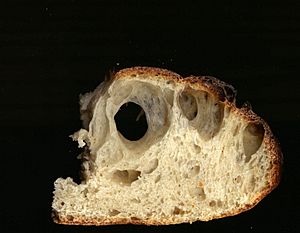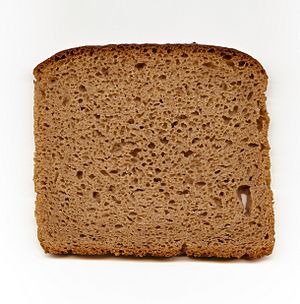Pore (bread) facts for kids
Pores are like tiny air bubbles you see inside bread. They are super important because they give bread its special texture, which bakers call the "crumb." These little holes are created by a process called fermentation, where tiny living things (like yeast) make carbon dioxide gas. This gas gets trapped in the dough, forming a network of interconnected spaces. The way these pores form greatly affects how soft, chewy, or dense a bread feels when you eat it.
Contents
What Are Bread Pores?
Pores are the small, empty spaces or air pockets found within a loaf of bread. Think of them as a network of tunnels and caves inside the bread. They are not just random holes; their size, shape, and how they connect to each other are key to the bread's overall feel.
How Do Pores Form in Bread?
The creation of pores is a fascinating part of baking. It mainly happens thanks to a process called fermentation.
The Role of Yeast and Gas
Most breads use a leavening agent like yeast or a sourdough starter. These are living microorganisms that love to eat sugars in the dough. As they eat, they produce carbon dioxide gas. This gas is what makes the dough rise.
Trapping the Gas
The dough itself is like a stretchy balloon. It contains gluten, which is a protein found in wheat flour. When you mix flour and water, the gluten forms a strong, elastic network. This network traps the carbon dioxide gas bubbles produced by the yeast. As more gas is made, the bubbles expand, creating the pores we see in the finished bread.
Why Pore Size Matters for Texture
The size and distribution of pores are major factors in determining the "crumb" of the bread. The crumb is what the inside of the bread looks and feels like.
Light and Airy Crumb
Breads with larger, more open pores often feel light and airy. They might have a chewy texture because of the way the gluten network stretches around the big bubbles. A good example is Sourdough bread, which is known for its big, irregular holes.
Dense and Fine Crumb
On the other hand, breads with smaller, more tightly packed pores tend to be denser. They might feel softer or more uniform. Rye bread is a great example of this, often having a very fine and compact crumb.
Different Breads, Different Pores
Different types of bread are known for their unique pore structures. This is often by design, as bakers aim for specific textures.
Sourdough Bread Pores
Sourdough bread often has a very open and irregular crumb with large, unevenly distributed pores. This is partly due to the wild yeasts and bacteria in the sourdough starter, which produce gas at different rates, and often a higher hydration (more water) in the dough.
Rye Bread Pores
Rye bread, especially those made with a high percentage of rye flour, typically has a much denser crumb with smaller pores. Rye flour has less gluten than wheat flour, so it can't trap as much gas, leading to a more compact texture.
Other Examples
- Baguettes: These French breads are famous for their open, airy crumb with large, irregular holes, similar to sourdough but often more uniform.
- Sandwich Bread: Most sandwich breads have a very fine, uniform crumb with small, consistent pores. This makes them soft and easy to slice, perfect for sandwiches.
How Bakers Control Pore Size
Bakers use several techniques to influence the size and shape of pores in their bread.
Flour Type and Hydration
The type of flour used is important. Flours with higher protein content (like bread flour) can form stronger gluten networks, which can trap more gas and lead to larger pores. The amount of water (hydration) in the dough also plays a role; wetter doughs often produce larger, more open pores.
Kneading and Proofing
How long and how intensely dough is kneaded affects the gluten network. Proper kneading develops the gluten, making it strong enough to hold gas. The proofing (rising) time is also crucial. If dough is proofed too little, pores will be small. If it's proofed too much, the gluten network can collapse, leading to a dense bread.
See also
 In Spanish: Alveolatura (pan) para niños
In Spanish: Alveolatura (pan) para niños



